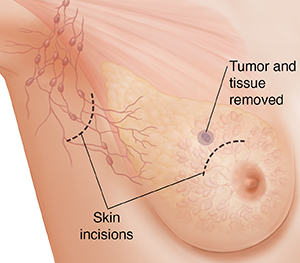Mastectomy
Mastectomy
Mastectomy is surgery to remove the breast. The most common mastectomies are called simple (or total) mastectomy and modified radical mastectomy. During these procedures, the chest muscle under the breast is not removed. As a result, arm strength remains. Keeping the chest muscle also makes reconstruction easier.
Simple (total) mastectomy
During a simple mastectomy, the breast tissue (lobules, ducts, and fatty tissue) and the nipple are removed. This surgery most often needs a hospital stay. Based on the results of surgery and follow-up tests, more treatment may be needed.
Modified radical mastectomy
This type of mastectomy is usually done to treat invasive cancer that has spread to the lymph nodes. During the procedure, the breast tissue and a strip of skin with the nipple are removed. Some of the lymph nodes under the arm are also removed. (These are lymph nodes in the arm pit.) The removed nodes are tested for cancer. Sometimes a surgical drain is used to keep fluid from building up. This drain usually stays in for 1 to 2 weeks after surgery. Modified radical mastectomy almost always needs a hospital stay. Based on the results of the surgery and follow-up tests, more treatment may also be needed.
Right after surgery
You will wake up in the recovery room. You may have an IV (intravenous) line for fluids and medicines. You will have a tight bandage (dressing) wrapped around your chest. There may also be a drain coming out of it. Pain medicines will be given to you as needed. A nurse will check your temperature, pulse, and blood pressure. You'll likely stay in the hospital for at least a day.
You will be given instructions on how to care for the dressing and drains, what kind of pain medicines you should use, and how to take care of yourself as you recover. You may be given arm exercises to do as you heal. Make sure you understand all the instructions and know when you need to next see your healthcare provider.
Risks and complications of mastectomy
Any type of surgery has some risk. Risks for mastectomy with reconstruction include:
Pain or numbness
Bleeding or infection
Swelling at the breast area
Stiffness of the shoulder
Fluid collection (seroma) in the area where the tumor was removed
Long-term swelling of the hand and arm (lymphedema)
Wound-healing problems and scarring
Talk with your healthcare provider about the risks related to your surgery and what you can do to help prevent problems.
When to call your healthcare provider
Call your healthcare provider right away if you have any of the following after surgery:
Fever
Chills
A change in the way the drainage looks or increased drainage
Increased pain, warmth, swelling, or redness at the incision
Cough or shortness of breath
Pain in the chest or calf
Bleeding that soaks the dressing
Any other problems your healthcare providers told you to watch for and report
Make sure you know how to reach your healthcare provider in case problems come up. Know what number to call with questions or problems after office hours, on weekends, and on holidays, too.
Updated:
February 09, 2018
Sources:
Mastectomy, UpToDate
Reviewed By:
Cunningham, Louise, RN,Image reviewed by StayWell medical illustration team.,Stump-Sutliff, Kim, RN, MSN, AOCNS
